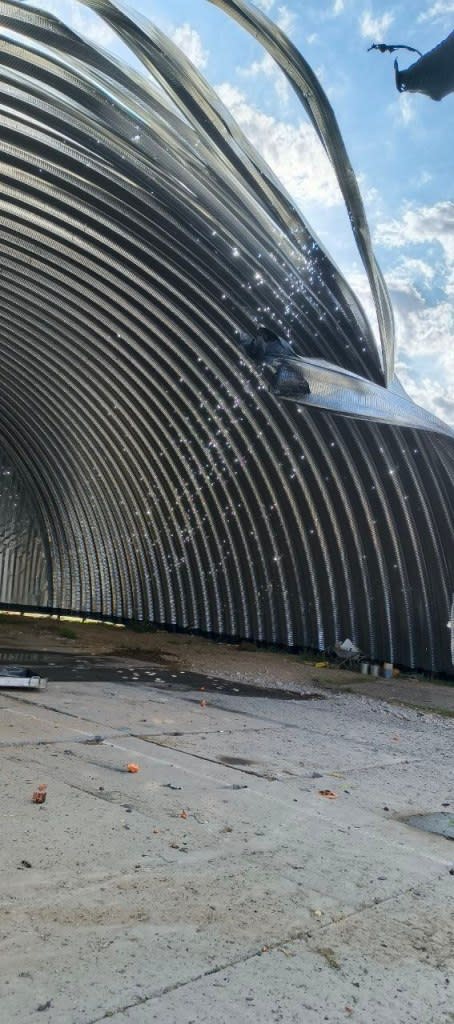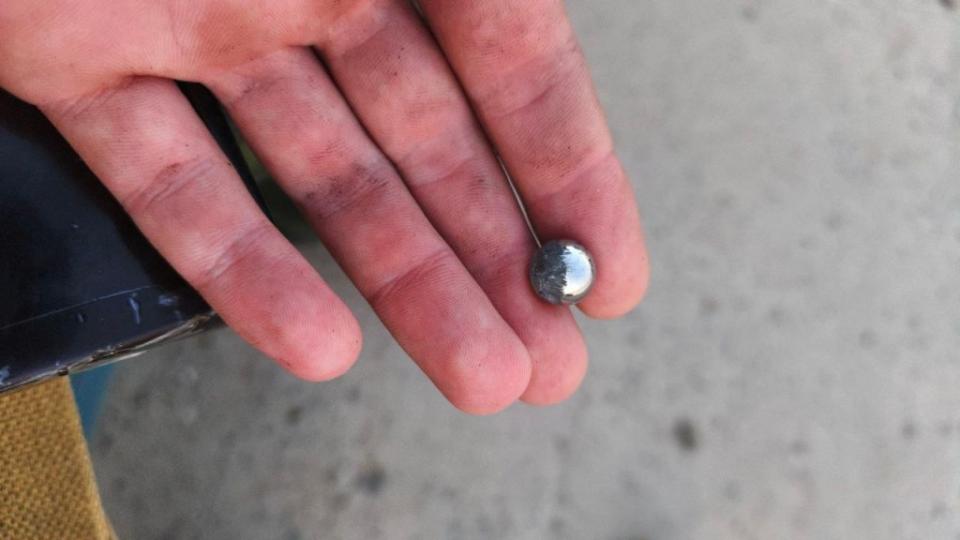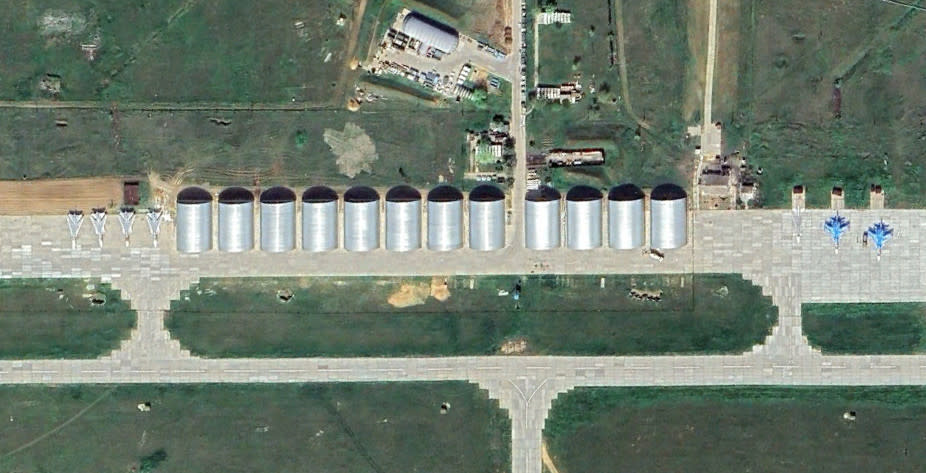Satellite images and post-strike photos emerging after a Ukrainian drone attack on Russia’s Marinovka Air Base show extensive damage to metal aircraft shelters on the flight path and in other parts of the base.
Some of the hangers that were hit contained aircraft that were likely to be heavily damaged, possibly severely, in the attack, the State Security Service of Ukraine (SBU) claimed. The base is located in Russia’s Volgograd region, about 300 miles from the current front lines.
Marinovka Air Base
… and the ‘AFTER’ picture (30cm from 22 Aug 2024 07:58 UTC)
Still analyzing but given your interest, I’m sharing what I think are the affected areas
Once again, less about airframes. Good amount of damage around the hangar and to the north https://t.co/Ows1Tus3Lkpic.twitter.com/LSbd54hcLo
– MT Anderson (@MT_Anderson) August 22, 2024
One image was posted on Telegram and enlarged by Radio Free Europe / Radio Liberty journalist Mark Krutov offers a better view of the aircraft caught in the hangar.
A closeup image of one of the hangars shows several small holes that indicate the munitions Ukraine uses containing ball bearings or other fragmentation devices on drones to maximize the damage they cause. This is a common practice in the Ukrainian battlefield and elsewhere.

Photographs have also emerged claiming to show shrapnel collected from the airfield. When War Zone unable to verify its authenticity, the Russian Air Force-affiliated Fighterbomber Telegram channel complained bitterly about people taking pictures of the attack.
“I wonder from the photos from Marinovka – are they just idiots taking pictures?” Fighterbomber asked. “A traitor for money? Or a poor man who is told to quickly give a photo report of the damage and usually send it via WhatsApp to his superiors?”

Other parts of the base were also affected, as open source researcher MT Anderson (@MT_Anderson) noted on Twitter. He also compared pictures before and after the attack showing the extent of the damage.
“Still analyzing but given the interest, I’m sharing what I think are affected areas,” he wrote. “Once again, less on airframes. Good amount of damage around the hangar and to the north.
Marinovka Air Base
… and the ‘AFTER’ picture (30cm from 22 Aug 2024 07:58 UTC)
Still analyzing but given your interest, I’m sharing what I think are the affected areas
Once again, less about airframes. Good amount of damage around the hangar and to the north https://t.co/Ows1Tus3Lkpic.twitter.com/LSbd54hcLo
– MT Anderson (@MT_Anderson) August 22, 2024
A close analysis by Anderson of the imagery taken on August 19 shows what appears to have been more than a dozen Su-24M Fencer swing-wing attack jets and more than a dozen Su-34 Fullback attack aircraft in the base. It is not known how many of the jets were on board at the time of the attack.
Earlier on Thursday, a video emerged after the attack, showing much of the base covered in thick smoke. Someone in the video can be heard expressing concern about the situation.
“It’s still flying,” he said, according to a translation provided by Anton Gershchenko, a former adviser to the Ukrainian government and frequent social media commentator. “This is still brazen. They have destroyed everything. The airfield has been bastardized. This is a serious tragedy, man. This is very serious… “
“It’s still flying. “It’s still chasing. He has destroyed everything. The airfield is broken. This is a serious tragedy, guys. This is very serious…” – the situation at the Marinovka military airfield in Russia’s Volgograd region. https://t.co/03C3JzU9ys pic.twitter.com/2ivd9mwhyP
— Anton Gerashchenko (@Gerashchenko_en) August 22, 2024
The SBU said it launched the attack, along with Ukrainian special operations forces, to destroy a guided bomb that was stored there among other targets, according to the SBU. Ukrainian Pravda (UP).
The SBU “is very precise in attacking airfields used for attacks against Ukraine,” the publication added, citing a source in the security agency. “Each strike reduces Russian air superiority and limits the aircraft’s capabilities.”
Local residents described the airfield “as a scene from an apocalypse movie after the Ukrainian drone attack,” UP reported. “A warehouse containing guided aerial bombs, ammunition and fuel and lubricants exploded on the airfield.”
As we noted in a story in June about the need for shelters for aircraft in the age of drones, Google Earth highlighted 12 aircraft shelters on the Marinovka flight path. Construction began in November last year. This is a relatively rare feature for Russian air bases. You can see the shelter in the picture below.

War Zone examines why these shelters are needed as part of a deeper dive into whether the U.S. should build tough shelters for fighter jets. From our story then:
“The specific impetus for building a shelter in Marinovka is unknown, but Russian forces claim to have killed a Ukrainian drone believed to be in Volograd in September 2023. Unmanned aerial systems with widespread and daily weapons, including long-range kamikaze. types and launched closer to the target, posing a real threat, including an aircraft seen on the apron at an air base deep inside Russia.
That is exactly what happened in Marinovka. We also wondered how the shelter would withstand an attack. Satellite images show that structures like this offer only partial protection from long-range drone attacks, which Fighterbomber said after the attack.
“By the way, the light aircraft shelter has had its baptism of fire,” writes Fighterbomber. “The one given as a gift.”
“Well, miracles don’t happen,” complained the Fighterbomber. “Let’s do it. We need a reinforced concrete structure. But this does not mean that a light shelter is not needed. They are needed wherever it is not possible to build a reinforced concrete structure. And as I said, they should be reinforced with gabions or concrete blocks along the perimeter.
However, these shelters appear to provide protection against some warheads and stop shrapnel from flying further and damaging other aircraft. They will be more effective against local attacks using drones controlled by personnel nearby and dropping bombs and other explosive devices. In addition, much of the utility comes from complicating the enemy’s ability to believe the target aircraft on the ground, because they can hide in some but not others. And thin corrugated metal will not stop a warhead fragmentation explosion under any circumstances. If you want that kind of protection, you’re going to need a tougher aircraft shelter than the Russians have installed at this base, and they certainly know that.
The metal shelters may not offer miracles, but due to their damage, the attack will destroy Russian aviation without them.
Contact the author: howard@thewarzone.com





